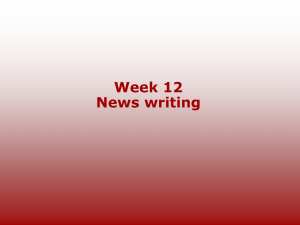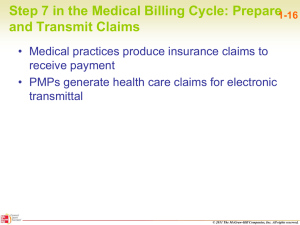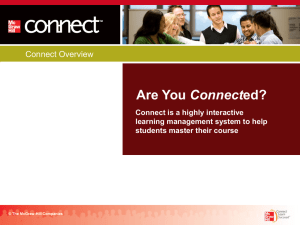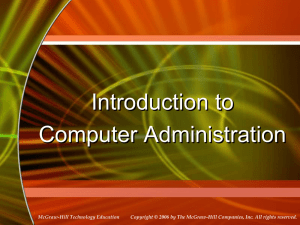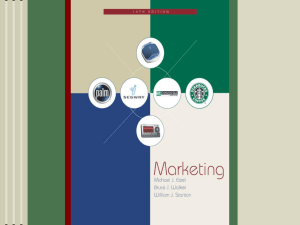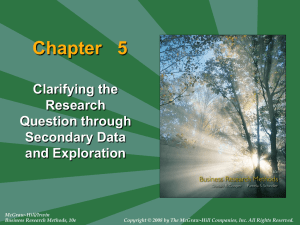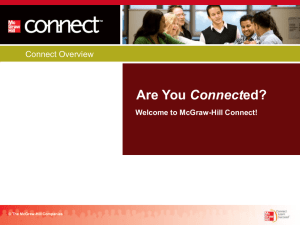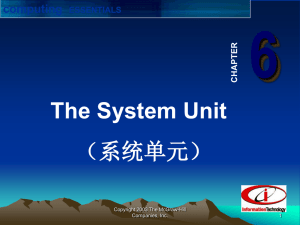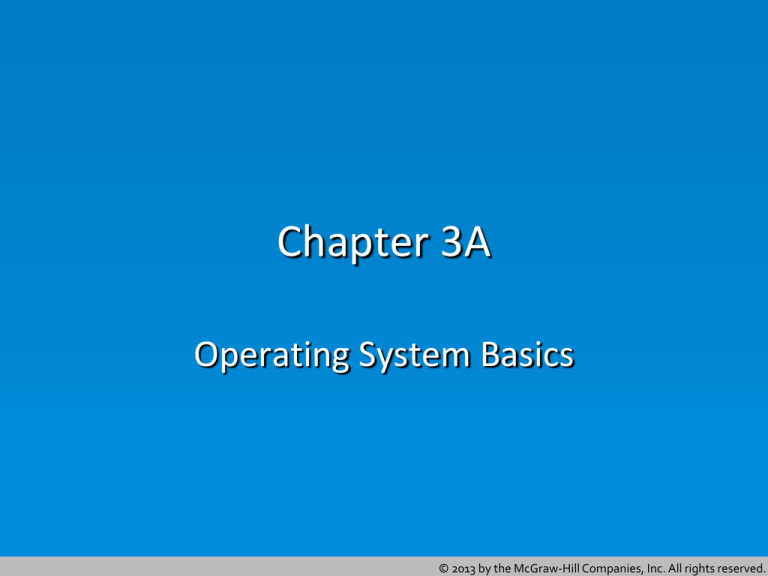
Chapter 3A
Operating System Basics
© 2013 by the McGraw-Hill Companies, Inc. All rights reserved.
2
Learning Objectives
3.1
3.2
3.3
3.4
Summarize the ways in which an operating
system works with the computer and user
Describe the way data are moved around the
computer and the basic concept of the
machine cycle
List and describe the major PC operating
systems
Explain how the Windows file system organizes
its files
© 2013 by the McGraw-Hill Companies, Inc. All rights reserved.
3
Types of Operating Systems
• Real-time operating system: A very fast, relatively small
OS designed to respond to requests almost instantly
• Single-user/single-tasking operating systems: Allow a
single user to perform just one task at a time
• Single-user/multitasking operating systems: Allow a
single user to perform two or more functions at once
• Multi-user/multitasking operating systems: Allow
multiple users to use programs that are simultaneously
running on a single network server (a terminal server)
© 2013 by the McGraw-Hill Companies, Inc. All rights reserved.
4
Functions of Operating Systems
• Supporting programs
• Sharing data between
windows and programs
• Managing the computer
hardware
• Working with device drivers
© 2013 by the McGraw-Hill Companies, Inc. All rights reserved.
5
Supporting Programs
• The operating system
manages all the other
programs that run on
the computer
• It provides services to
these programs when
they use system calls to
request the services
© 2013 by the McGraw-Hill Companies, Inc. All rights reserved.
6
Windows: Sharing Data
• Clipboard - a temporary holding place in the
computer’s memory
– Cut command - moves the data out of the application and
onto the Clipboard
– Copy command - leaves the data in place and a copy of it
is saved on the Clipboard
– Paste command - moves the data from the Clipboard into
the document
• Clipboard can be used for moving data between
different programs, a feature enhanced by OLE
(Object Linking and Embedding)
© 2013 by the McGraw-Hill Companies, Inc. All rights reserved.
7
Managing Computer Hardware
• The operating system is the intermediary between
the programs and the hardware devices
• Processing interrupts so programs and hardware
subsystems work in harmony
– An interrupt is a request for attention by some part of a
computer system
© 2013 by the McGraw-Hill Companies, Inc. All rights reserved.
8
Working with Device Drivers
• Device drivers are programs that allow the OS and
other programs to use a hardware device
• The operating system provides some of the device
drivers
• Others may come with purchase of the device
© 2013 by the McGraw-Hill Companies, Inc. All rights reserved.
9
Binary and Text Code
• Binary: the computer’s number system
• Text code - list of which combinations of bits
represent which characters
– ASCII : Eight-bit code that specifies characters for values
from 0 to 12
– Extended ASCII : specifies characters for codes from 128
to 255
– Unicode Worldwide Character Standard: Represents each
letter, number, or symbol with up to four bytes
© 2013 by the McGraw-Hill Companies, Inc. All rights reserved.
10
Moving Data
• Bus: electronic path used to transfer data between
hardware components
– Parallel bus: sends information parallel across multiple
wires
– Serial bus: sends information one bit at a time in series
– Internal bus: Connects the CPU to memory modules
– External bus: Connects external devices to the CPU
© 2013 by the McGraw-Hill Companies, Inc. All rights reserved.
11
External Bus Standards
• IEEE 1394 : typically used to transfer video and audio
data
• PCI bus: designed to integrate various hardware
devices into a computer
• PCI Express: replacement technology for the PCI bus
• SATA: Current standard for connecting hard drives to
the computer
• USB: found on all modern personal computers and
supports a host of hardware devices
© 2013 by the McGraw-Hill Companies, Inc. All rights reserved.
12
Cache Memory and CPU
• Cache - a smaller, faster memory subsystem than the
computer’s main RAM
• The CPU has two basic parts for processing data:
– Control unit: directs the flow of data through the CPU
(Contains the CPU’s instruction set and is expressed in
microcode)
– Arithmetic logic unit : Carries out the processing that
involves comparing numbers (logical operations) or
carrying out arithmetic operations
© 2013 by the McGraw-Hill Companies, Inc. All rights reserved.
13
Cache Memory and CPU
• Machine cycle: Complete set of steps in executing an
instruction
– Instruction cycle
• Fetching: Retrieve a command or data from memory.
• Decoding: Break down the command into instructions that
correspond to those in the CPU’s instruction set.
– Execution cycle
• Executing: Carry out the instructions in order.
• Storing: Store results of the instruction in memory (not always
necessary).
© 2013 by the McGraw-Hill Companies, Inc. All rights reserved.
14
Operating Systems Concepts
• Bit size: Number of bits the OS uses to represent
values
• Every byte of a computer's RAM has its own unique
numeric identifier, called an address
• Backward compatible : an OS designed to work with
most or all of the programs that were created for the
old version
• Emulator – a software program designed to recreate the exact environment of the older program
© 2013 by the McGraw-Hill Companies, Inc. All rights reserved.
15
Common Operating Systems
•
•
•
•
Windows
Mac OS X
Linux for Desktop PCs
Others:
–
–
–
–
–
DOS
Unix
iOS
Android
Chrome OS
© 2013 by the McGraw-Hill Companies, Inc. All rights reserved.
16
Organizing Disk Storage
• Formatting : Magnetically mapping the disks’ surface
so the computer can go directly to a specific point on
it
• Stages of formatting
– Forming tracks - concentric
rings on each side of the disk
– Dividing tracks into sectors locations where binary data is
physically stored
© 2013 by the McGraw-Hill Companies, Inc. All rights reserved.
17
Finding Data on a Disk
• File system - logical method for managing the
storage
• When a disk is formatted, four areas are created:
– Boot sector: A program that runs when the computer
starts up, in a process called booting
– File allocation table (FAT): Keeps track of file locations
– Root folder: A folder that holds information about all the
other files on the disk
– Data area: The remaining area of the disk
© 2013 by the McGraw-Hill Companies, Inc. All rights reserved.
18
File Systems
• New Technology File System (NTFS) : A newer file
system that offers better security and performance
• Web-Based Distributed Authoring and Versioning
(WebDAV) : file system describes a structure for
managing access and changes to files that are stored
online
• Shortcut: An object that points to another file; not
reflected in the disk’s actual file structure
© 2013 by the McGraw-Hill Companies, Inc. All rights reserved.
19
Optimizing Disk Performance
• Utilities: Software programs that offer new features
for the OS or enhance them
– Backup utilities can help you copy large groups of files
from your computer to another storage medium
– Anti-malware examines files, memory and parts of the
operating system to detect and remove malware
– Firewall utilities examine traffic coming from your
computer to the Internet, and vice versa
– Screen savers display a moving image or sequence of
pictures on the computer screen
© 2013 by the McGraw-Hill Companies, Inc. All rights reserved.

